I am working with alphanumeric data from a mainframe. Due to the nature of the access point, the GetString method is used within a webbrowser interface to pull data from the mainframe. I am refactoring my code as well as older code to make use of data structures instead of merely range objects, as range object code takes far longer with large data sets.
As a part of general optimization practice, I run all large data set macros with Application.ScreenUpdating = False and Application.Calculation = xlCalculationManual active. To time it, I use QueryPerformanceCounter with a DoEvents after using the Counter in conjunction with the statusbar, so that it provides me the time it takes to complete a particular macro. The QueryPerformanceCounter is located in a Class Module and has played no direct role in executing the domain logic / business logic of my code.
For instance, I recently refactored code that pulled 10,000 or so strings from the mainframe screen and placed them into a worksheet via a loop. When refactored into a datastructure loop, the code takes around 70 seconds when shucking the strings into an array. The code is also more portable, in that those strings could as easily be shifted/placed to a dictionary for sorting or a collection for parsing. I am therefore switching all my VBA code from range-based to datastructures, and this is the lead-in/background for my question.
I came across some older code during an analysis project that has some interesting logic for pulling content from the mainframe. In essence, the code pulls content from the server in this layout form:

And then parses the the content into this form in an excel sheet using Worksheet/Cell logic as a framework:

The code, sans the login/access logic as well as sans subroutine declarations, is as follows:
Sub AcquireData()
CurrentServerRow = 13
WhileLoopHolder = 1
If Trim(CurrentSession.Screen.Getstring(CurrentServerRow, 9, 7)) <> "" Then
NewWorksheetLine_Sub
End If
Do While WhileLoopHolder = 1
If CurrentSession.Screen.Getstring(CurrentServerRow, 9, 1) = "-" Then
If Trim(CurrentSession.Screen.Getstring(CurrentServerRow + 1, 15, 1)) <> "" Then
NewWorksheetLine_Sub
End If
ElseIf Trim(CurrentSession.Screen.Getstring(CurrentServerRow, 9, 7)) = "" Then
If Trim(CurrentSession.Screen.Getstring(CurrentServerRow, 58, 14)) <> "" Then
Cells(WorksheetRow, ValueSets) = Trim(CurrentSession.Screen.Getstring(CurrentServerRow, 58, 14))
ValueSets = ValueSets + 1
End If
Else
If CurrentSession.Screen.Getstring(CurrentServerRow, 5, 1) = "" Then
Cells(WorksheetRow, WorksheetColumn) = "X"
Else
Cells(WorksheetRow, WorksheetColumn) = CurrentSession.Screen.Getstring(CurrentServerRow, 5, 1)
End If
Cells(WorksheetRow, WorksheetColumn + 1) = CurrentSession.Screen.Getstring(CurrentServerRow, 9, 7)
Cells(WorksheetRow, WorksheetColumn + 2) = Trim(CurrentSession.Screen.Getstring(CurrentServerRow, 17, 39))
Cells(WorksheetRow, ValueSets) = Trim(CurrentSession.Screen.Getstring(CurrentServerRow, 58, 14))
WorksheetColumn = WorksheetColumn + 3
ValueSets = ValueSets + 1
End If
CurrentServerRow = CurrentServerRow + 1
If CurrentServerRow > 41 Then
WhileLoopHolder = 0
End If
Loop
End Sub
Sub NewWorksheetLine_Sub()
WorksheetRow = WorksheetRow + 1
WorksheetColumn = 1
ValueSets = 10
End Sub
This code is nested in a loop within another program, and thereby pulls thousands of lines and organizes them neatly. It also takes hours and wastes valuable time that could be used analyzing the data acquired from the server. I managed to refactor the basic code into a data structure, and used my learning to refactor other code as well. Unfortunately, I refactored this particularly code incorrectly, as I am unable to mimic the business logic correctly. My snippet is as follows:
Sub AcquireData()
'This code refactors the data into a datastructure from a range object, but does not really capture the logic.
'Also, There is an error in attempting to insert a variant array into a collection/dictionary data structure.
CurrentServerRow = 13
ReDim SourceDataArray(10)
WhileLoopHolder = 1
If Trim(CurrentSession.Screen.Getstring(CurrentServerRow, 9, 7)) <> "" Then
NewWorksheetLine_Sub
End If
Do While WhileLoopHolder = 1
If CurrentSession.Screen.Getstring(CurrentServerRow, 9, 1) = "-" Then
If Trim(CurrentSession.Screen.Getstring(CurrentServerRow + 1, 15, 1)) <> "" Then
NewWorksheetLine_Sub
End If
ElseIf Trim(CurrentSession.Screen.Getstring(CurrentServerRow, 9, 7)) = "" Then
If Trim(CurrentSession.Screen.Getstring(CurrentServerRow, 58, 14)) <> "" Then
ReDim Preserve SourceDataArray(ValueSets)
SourceDataArray(ValueSets) = Trim(CurrentSession.Screen.Getstring(CurrentServerRow, 58, 14))
ValueSets = ValueSets + 1
ReDim Preserve SourceDataArray(ValueSets)
End If
Else
If CurrentSession.Screen.Getstring(CurrentServerRow, 5, 1) = "" Then
ReDim Preserve SourceDataArray(WorkSheetColumn)
SourceDataArray(WorkSheetColumn) = "X"
Else
SourceDataArray(WorkSheetColumn) = CurrentSession.Screen.Getstring(CurrentServerRow, 5, 1)
End If
SourceDataArray(WorkSheetColumn + 1) = CurrentSession.Screen.Getstring(CurrentServerRow, 9, 7)
SourceDataArray(WorkSheetColumn + 2) = Trim(CurrentSession.Screen.Getstring(CurrentServerRow, 17, 39))
SourceDataArray(ValueSets) = Trim(CurrentSession.Screen.Getstring(CurrentServerRow, 58, 14))
WorkSheetColumn = WorkSheetColumn + 3
ValueSets = ValueSets + 1
ReDim Preserve SourceDataArray(ValueSets)
End If
CurrentServerRow = CurrentServerRow + 1
If CurrentServerRow > 41 Then
WhileLoopHolder = 0
End If
Loop
End Sub
Sub NewWorksheetLine_Sub()
SourceIndexAsString = SourceCollectionIndex
SourceDataCollection.Add SourceDataArray(), SourceIndexAsString
SourceCollectionIndex = SourceCollectionIndex + 1
WorkSheetColumn = 1
ValueSets = 10
End Sub
I have considered that in order to use the same type of "cell" logic, I may want to use arrays nested within an array, and then transpose that to a worksheet. However, I have been thus far unsuccessful in implementing any such solution these past few weeks. Also, there may be a superior method of refactoring the logic to a datastructure form. However, I have been unable to determine how to do so successfully.
To summarize, my questions are as follows: In what way(s) can I shift "cell"-based logic to data structure logic? What is the best data structure for doing so? In this particular case, how can I implement the use of data structure logic with the this business logic?